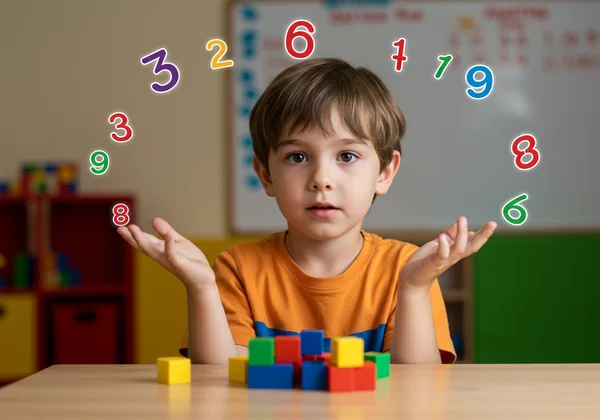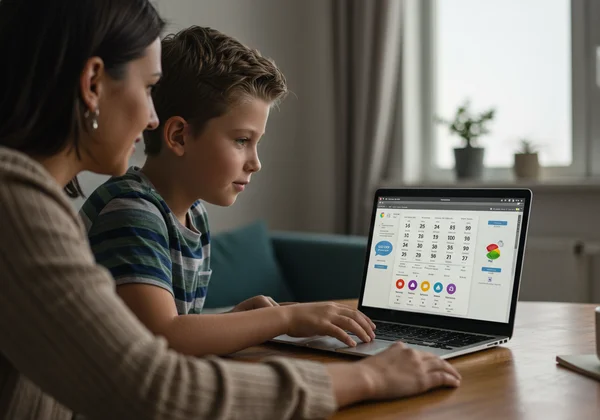Spotting Dyscalculia: Key Signs & Screening for Your Child
As a parent or educator, it’s heartbreaking to watch a child struggle with math. When homework sessions consistently end in frustration and tears, it's easy to wonder if it's just a lack of effort or something more. If your child seems to be falling behind their peers despite trying their best, you might be looking for answers. It's often more than just "being bad at math"—it could be dyscalculia, a specific and common learning difference that affects a person's ability to understand and work with numbers. What are the signs of dyscalculia in children?

Understanding the dyscalculia signs a child may exhibit is the first crucial step toward providing the right support. This guide is here to help you recognize these signs across different age groups, from elementary school to the teenage years. By identifying these challenges early, you can empower your child with the tools and strategies they need to build confidence and succeed. If you're ready to gain clarity on your child's struggles, take the first step with an initial screening.
Early Signs of Dyscalculia in Young Children (Ages 7-9)
In the early school years, math foundations are built. For a child with dyscalculia, this period can be particularly challenging. The signs are often subtle and can be mistaken for simple developmental delays, but they form a consistent pattern of difficulty with core numerical concepts.
Difficulties with Number Sense & Counting
A core deficit in dyscalculia is a weak "number sense." This is the intuitive understanding of what numbers mean, how they relate to each other, and how they represent quantity. A child with these difficulties might struggle to connect the number "4" to four objects. They may have trouble counting backwards, frequently lose their place while counting, or struggle to recognize which of two numbers is larger. These are fundamental number concepts that can hinder all future math learning.

Struggles with Basic Math Facts & Operations
While their peers begin to quickly recall simple math facts like 2+3=5, a child with dyscalculia may continue to rely on finger counting for an extended period. They find it incredibly difficult to memorize addition, subtraction, or multiplication tables. Their arithmetic skills don't become automatic, meaning every simple calculation requires immense mental effort, making more complex problems nearly impossible to tackle.
Challenges with Telling Time & Handling Money
Dyscalculia often extends beyond worksheets and into everyday life. These children may struggle with practical math applications. Reading an analog clock can be a significant hurdle because it involves understanding number sequences, spatial arrangement, and units of time. Similarly, handling money, making change, or understanding the value of different coins can be confusing and overwhelming.
Dyscalculia Symptoms in Middle Schoolers (Ages 10-13)
As math becomes more abstract in middle school, the dyscalculia symptoms teenagers experience can become more pronounced. The gap between them and their peers may widen, leading to increased academic and emotional distress. It's a critical time for identification and support.
Persistent Trouble with Multi-Step Math Problems
Math in middle school moves beyond single operations. Solving word problems or equations with multiple steps requires a student to hold information in their working memory, identify the correct operations, and execute them in sequence. A child with dyscalculia may feel lost, unable to track the steps, or mix up the order of operations, even if they understand each individual component.
Relying Heavily on Concrete Aids or Counting on Fingers
By this age, most students have achieved math automaticity, meaning they can recall basic math facts without conscious thought. A middle schooler who still consistently uses their fingers to solve 8+5 or needs physical objects to visualize multiplication is showing a clear sign of persistent difficulty. This reliance on concrete aids prevents them from engaging with more abstract mathematical ideas.
High Levels of Math Anxiety & Avoidance
Years of struggling can take a significant emotional toll. Many children with dyscalculia develop severe math anxiety. This is more than just a dislike for the subject; it's a genuine feeling of panic or dread when faced with numbers. This anxiety can lead to avoidance behaviors, such as "forgetting" homework, feeling sick before math class, or acting out to avoid participating.

Recognizing Dyscalculia in Teenagers (Ages 14-16)
In high school, the challenges of dyscalculia can impact not only grades but also preparation for adult life. A dyscalculia test a teenager might take could reveal difficulties that affect everything from advanced coursework to daily planning.
Significant Difficulties with Algebra & Abstract Math
High school math is dominated by abstract concepts like variables, functions, and graphing. For a teenager with dyscalculia, this leap from concrete numbers to abstract symbols can be incredibly difficult. They may struggle to grasp the logic behind algebraic formulas or understand how 'x' can represent an unknown value. This difficulty with abstract reasoning can make courses like Algebra and Geometry feel insurmountable.
Poor Organizational Skills Involving Numbers
The impact of dyscalculia often spills into life skills that require numerical organization. This can manifest as poor financial literacy, such as an inability to create or stick to a simple budget, estimate costs, or calculate a tip. They might also struggle with scheduling, misinterpreting timetables, or having trouble estimating how long a task will take.
Trouble with Spatial Reasoning & Directions
An often-overlooked symptom is difficulty with spatial awareness. This can include confusing left and right, struggling to read maps or follow directions, and having a poor sense of distance and speed. The brain regions that process numerical information are closely linked to those that handle spatial information, so challenges in one area often accompany challenges in the other.
When to Consider a Dyscalculia Screening Test
If several of the signs described in this article resonate with your child's experience, you may be wondering what to do next. This is precisely the point where testing for dyscalculia can provide clarity and a path forward. A screening is a powerful first step.
Understanding the Purpose of a Screening Tool
It's important to know that an online screening isn't a formal medical diagnosis. Instead, it is a valuable educational assessment designed to identify at-risk individuals. Our free and accessible dyscalculia assessment was designed by educational psychologists and math experts to analyze the key cognitive markers associated with this learning difference. It provides you with an initial data point, helping you understand whether your child's struggles align with the typical profile of dyscalculia.
The Benefits of Early Identification and Support
Identifying dyscalculia early is empowering. It allows you to shift the focus from "my child is lazy" to "my child learns differently." This knowledge opens the door to targeted learning support, both at home and at school. With the right strategies and accommodations, children can develop coping mechanisms, build on their strengths, and regain lost confidence. Taking a free online test can be the start of this positive journey.

Your Next Step: Understanding & Support for Your Child
Recognizing the signs of dyscalculia is a monumental step toward helping your child. These challenges are not a reflection of their intelligence or effort but an indication of a different way their brain processes numbers. With understanding and the right tools, you can help them navigate their mathematical journey successfully.
Don't let uncertainty and frustration continue. Empower yourself with knowledge and give your child the support they deserve. Take the free screening test on our website today. It’s a quick, confidential, and expert-designed way to gain initial insights and access an optional, AI-powered report with personalized strategies to help your child thrive.
Frequently Asked Questions About Dyscalculia Signs & Testing
How do you test for dyscalculia in a child?
The process often begins with a screening tool like ours to identify potential signs. Our online test assesses various skills, including number sense, calculation fluency, and math anxiety. If the screening indicates a high likelihood of dyscalculia, the next step is a comprehensive evaluation by a qualified professional, such as an educational psychologist, who can provide a formal diagnosis.
What are the primary signs of dyscalculia in children and teenagers?
The signs vary by age. In young children, look for trouble with basic counting, recognizing numbers, and learning math facts. In middle schoolers and teenagers, signs include persistent difficulty with word problems, high levels of math anxiety, and struggles with abstract concepts like algebra and practical skills like budgeting or telling time.
Is there a free online dyscalculia screening test for my child?
Yes, there is. We offer a comprehensive, free screening test designed by experts to help parents and educators identify the signs of dyscalculia in children (ages 7+) and teenagers. You can access our free screening directly on our homepage to get started in minutes.
Do all children who struggle with math have dyscalculia?
No, not all difficulties with math are due to dyscalculia. Math struggles can also be caused by other factors, such as math anxiety, gaps in instruction, or other learning differences like dyslexia or ADHD. A screening is a helpful tool to begin differentiating between these possibilities and to find answers now.